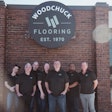
 Inventory is just one report you should track regularly.
Inventory is just one report you should track regularly.
As retailers, we're living in what I like to call the Era of Big Data. Without using data and analytics to compete with the likes of Amazon, your business is going to disappear.
But though the need to transform is more acute than ever, it's natural to be wary of change or unsure of how to start unraveling your business to take a hard look at it. How do you examine it in a way that makes sense and actually helps? The groundwork begins when you start figuring out your business's real story. And I'm not talking about the one on your website's "About" page—I'm talking about its numbers. Here are some of the basic numbers reports you'll need to effectively evaluate your business.
Profit and Loss: monthly updates on how you're doing
It's hard to overstate the importance of having a talented bookkeeper or accountant, as there are several incredibly useful reports to gather for your business—not the least of which is your Profit and Loss report. This report contains your total income and total expenses, and it should be run monthly. What makes me crazy is that the average business person I consult with does not ask for this type of report for more than a year; they'll say, "I don't need to, I know it." Oh really? Some other retailers I speak with just keep it on pieces of paper. This report is the best way to see how your business is doing—take good care that it's correct!
Operating report: vital daily data
Operational reports are extremely illuminating, yet I've noticed few retailers do most of them. Here are a few of the essential ones:
1) Daily Average Sale: This is calculated by adding up the amount of money made today and dividing it by the number of sales.
2) Daily and Hourly Traffic: This can be tracked using a counter like they do at Costco.
3) Conversion Rate: An insightful report to have when it comes to setting sales goals.
4) Sales by Percentage Against the Whole: This shows you what your top selling products are and in what percentage against the whole of your business.
5) Sales by Customer by Period: This helps us realize who our customers are, how much money they spend with us, and when they've visited (remember: 80 percent of sales come from 20 percent of customers).
RELATED: Small Business Accounting Basics
All of the numbers derived from these reports contain the information you'll need to start evaluating your business. But before you do that, you'll also need to take a long, hard look at another vital aspect of your business—inventory.
Inventory: what you need and what you don't
If you find that what you're selling and what you're stocking are not the same thing, now's the time to begin asking yourself why.
There's no misunderstanding on my part that the average retailer carries inventory long after it shouldn't be in the store. I try to set a cut-off period of 12 months for inventory, as there is a ton of money tied up in it.
You can also consider what you should be stocking more of. As you hear customers come in and ask for a product you don't carry, you have to ask yourself, are you going start stocking that item? Why not?
Sales targets: putting the numbers into practice
Now that you've figured out your numbers, you can begin putting them to use, beginning with your sales targets. I tell my clients to aim for 20 percent above the prior year's sales numbers.
So let's say sales were $500,000 in 2018—20 percent is an additional $100,000, meaning you'll earn $600,000 in 2019. You're probably thinking, "Okay, Barb's nuts." But here's the way I look at things: We only increase our business one client at a time, right? So let's simplify things and focus on each individual client, looking at our numbers to find what our average sale is. Say our average sale is $2,000, 20 percent of which is $400. This means that when a customer spends the average $2,000, you know that to hit a 20 percent increase, you've got to start showing more products to earn $400 more. It's all about add-on sales.
Here's another helpful way to use your data: Let's say you and I have a goal of $20,000 in sales for the day, with an average sale of $2,000. That means we each have to make five sales. But what is your closing rate? Let's say we both have a 50 percent closing rate; each of us will have to talk with at least 10 customers each. Then you might say, "Barb, I don't have that many customers come into the store." BINGO! And there we have an issue we can work on: marketing.
Once you embrace the Era of Big Data and get these ideas into the culture of your retail store, you'll pinpoint numerous ways to improve—all thanks to simply knowing the numbers.

































